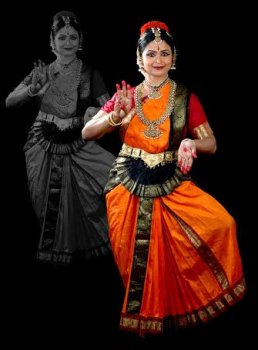
|
 |

|
 |
Nritta - The journey into Shanta rasa - Padmaja Suresh e-mail: padmajasuresh@hotmail.com May 4, 2014 All dancers have to look deep and answer what nritta means to them, causes in them and the spectators. The avid sishya in me was introspecting. 'Laya', taken from 'Pralaya' is dissolution, absorption and concentration. Shuddha Nritta is pure, it's Tala - Laya, the dance of Shakti and Shiva, Bindu and Nada. Nritt - aa / to cause to dance, blends male and female principles - Tadatmya identified as Ardhanareeswara. A cosmic creative vibration, Sphota / Nada, gets consolidated into Sabda Brahman or differentiated sound energy, symbolized by OM. From this arises cosmic intelligence, the creative spirit. Nritta is this pure creation, sustenance and destruction. Science today (Quantum physics) calls that GOD PARTICLE, the atomic dance of Nataraja. Nataraja does the Tandava in Shambhavi mudra, the meditative eyes in samadhi. He is NIRGUNA PARABRAHMAN in this perfect Jnani's posture. The steady breath and the balance mean that the Naadis of Ida, Pingala and Sushumna or the sun, moon and fire are purified and the Vayus /Pancha Pranas are ascending towards the thousand petalled lotus of Sahasrara Chakra. It is the outwardly depiction of the inwardly esoteric Sri Chakra, consisting of the shapes and designs like the triangle integral in Bharatanatyam, besides others and constantly tapping to the sound. It is the fire of the mystery of Kundalini- serpent power. How can one do nritta well unless one practices and maintains the Asanas and Pranayama as in Yoga and tunes to music?  The Gatis, Jatis and Nadais depict the tempo of the function of SRISHTI, STHITI, SAMHARA, TIRODANA and ANUGRAHA. The vibration of syllables TA DI TOM NAM, resounding from within the microcosm have no poetic words, meaning or emotion. Were they derived from Beeja Aksharas of mantras, the roots of the substratum from which other fleeting emotions, expressed through meaningful words, arise and then descend? Is it the self surrender, spoken as 'Nam'/ Prostrations, proceeding / HI to THAT (TAD HI)? The lines that divide the REAL and UNREAL seem to be discerned in NATYA YOGA through depiction of the worldly realm in abhinaya and the astral as well as causal realm in nritta. The final deliverance from Maaya…Para-Turiya! Nritta originates, evokes and dissolves into Shantam. In fact, all emotions do so finally and nritta, bereft of emotions, remains so. It is pure Yogic expression of THAT which cannot be expressed, Anirvachaneeya. Why was Shanta rasa (the same Nataraja as Dakshinamoorthy) added on after the eight rasas of Natya Shastra? Is eternal peace, both the beginning (expressed as love) and then the end (bliss)? Nritta, being essentially tranquil, denotes ethereal bliss (not ephemeral joy) and this is what makes it enjoyable for everyone alike, beyond language, religion or regional barriers. Rhythm is inherent in everyone, every aspect of nature and one becomes ONE (Tanmayate) with the dance. One who is adept performs nritta, also to Anahata Dhwani (silent voice from within the innermost heart). It is this voice of the soul which unites with the sound reflected by the sense organ and becomes Universal Bliss as all Dvaita, dual difference is burnt into Advaita, One absoluteness. Even blind, deaf and dumb or disabled can perform nritta without causing disturbance to visual appeal. The syllables used in nritta were derived from such roots, which give voice to the Vedantic dictum - TATTWAMASI. Shuddha Shaiva Siddhanta, the evolutionary period for dance, is equal to Vedanta, the objective of which is to ultimately have the vision of that DANCE which scales that heights of NADA sphere and attains perfection in NADANTA, formless sound beyond. (Tirumoolar's Tirumandiram / Tantra five- verse 1421). 'The body and breath appropriately trained, they reach the Turiyatita; there they witness the felicitous dance of the lord, drinking the fill of bliss, They Siva become……'(Tirumoolar's Tirumandiram / Tantra Eight-verse 2186). Does the dancer experience the rasa or only the spectator? Since the dancer enacts so many travelling emotions, she is the carrier of several bhavas, causing rasa in spectators. She is aware of what the spectators see through the eyes but in reality, when her third eye opens, she cannot be truly experiencing anything but the One that transcends, Shuddha SHIVAM / SHANTAM. Bangalore based Bharatanatyam, teacher, researcher, social worker and choreographer, Dr. Padmaja Suresh has performed at major dance festivals throughout the country. She has been on ICCR delegations and several concerts abroad. Deeply spiritual and intellectual, her book Tantra the Science and Natya the Art has been well appreciated for its esoteric study of dance. Post your comments Please provide your name and email id when you use the Anonymous profile in the blog to post a comment. All appropriate comments posted with name & email id in the blog will also be featured in the site. |